Bouldering vs. Rock Climbing: What’s the Difference? (2024)
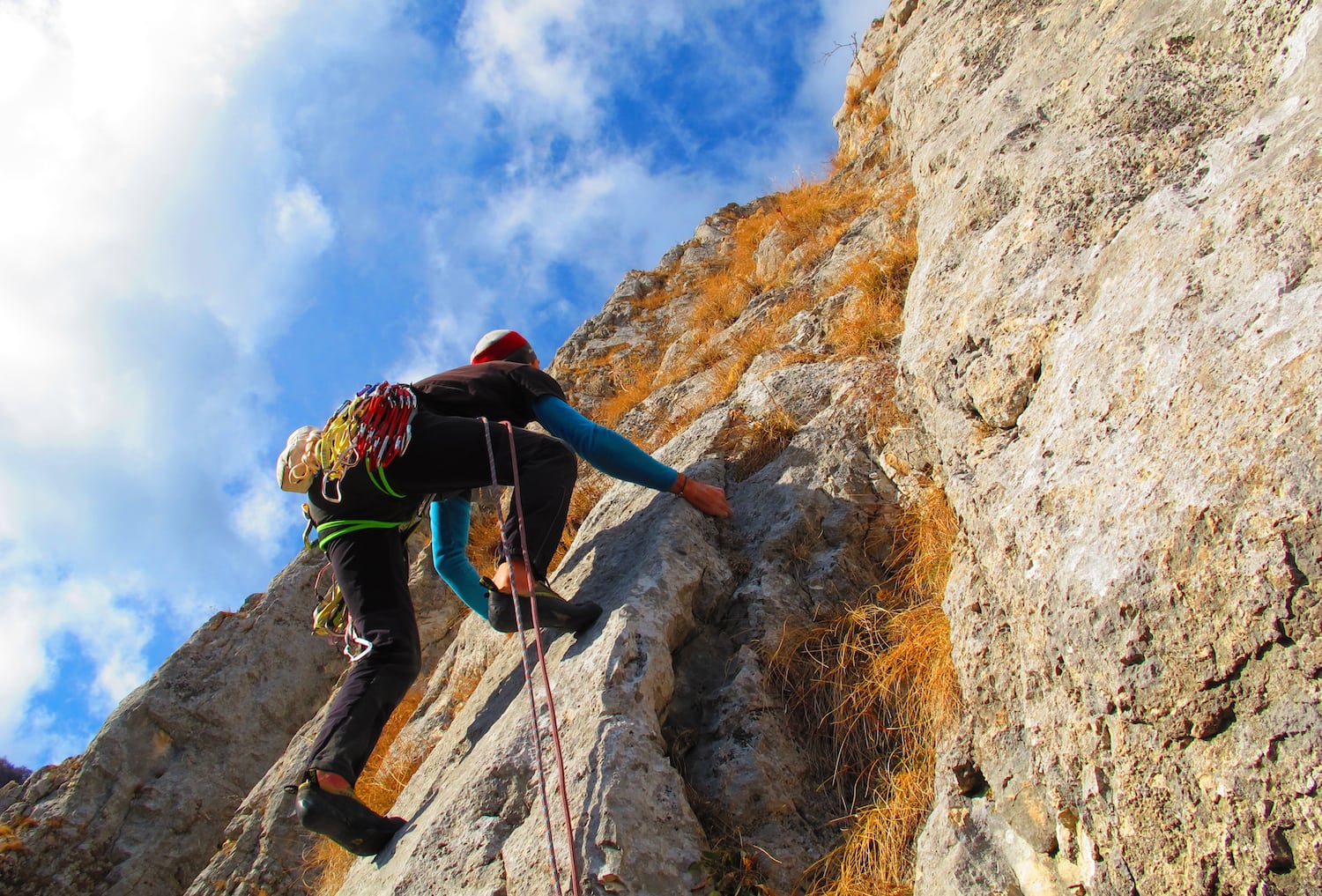
Published on: 04/10/2022
The sport of rock climbing, both indoors and out, is one of the most rapidly growing athletic pursuits of the past decade. This activity–once considered the realm of daredevils and slackers–has recently gotten even more widespread attention with the release of big-budget films like Free Solo and The Dawn Wall.
These movies, and the addition of rock climbing as an official Olympic sport, have likely inspired a new generation of next-level rock climbers. They will take rock climbing in directions we can’t predict.
With the rise of bouldering gyms worldwide, especially in big cities, it’s essential to look at what bouldering exactly is and how it relates to rock climbing. In this article, we’ll define bouldering vs. rock climbing and discuss the implications in terms of difficulty, training safety, and equipment.
What Is Bouldering?
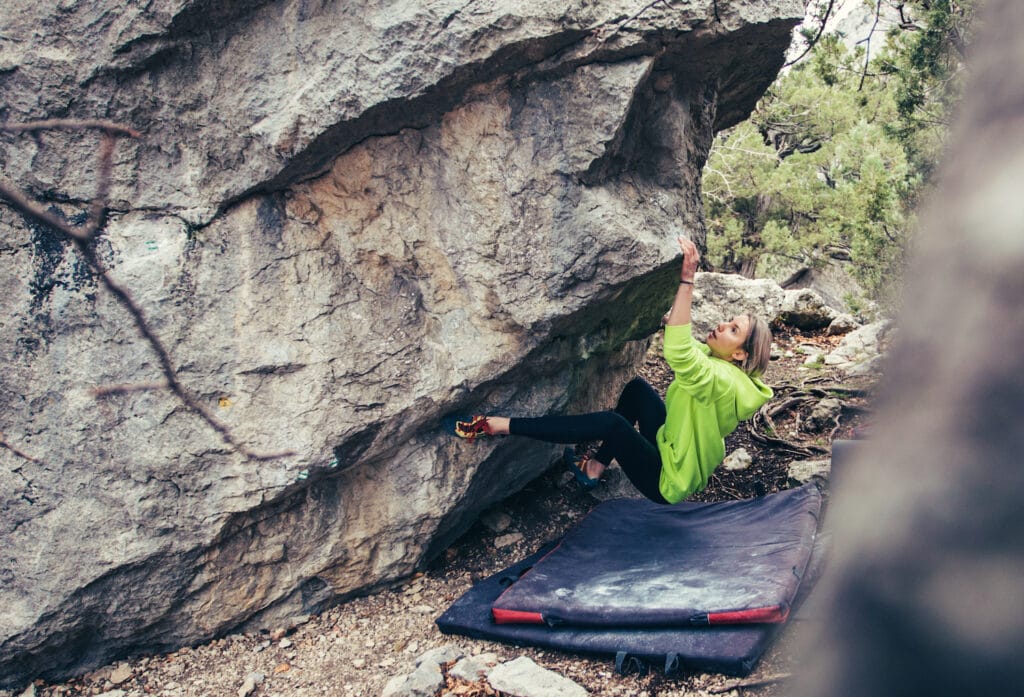
One subgenre of climbing that hasn’t received as much mainstream notice is a style of climbing called bouldering.
Bouldering means climbing without a rope, on rocks, or on indoor walls where a fall isn’t likely to cause severe injury or death. While that threshold is different for everyone, bouldering usually takes place on walls or boulders less than 15 feet (4.5 m) tall.
When most non-climbers picture rock climbing, they imagine people using ropes and other gear to climb tall cliff faces or mountain summits. So, for this article, rock climbing refers to free climbing with ropes and equipment used to protect a falling climber from injury. Bouldering falls are only protected by human spotters and portable pads or mats that cushion the landing zone.
Free Climbing vs. Free Soloing

It’s a common misunderstanding to think that free climbing means a free climber is not using a rope for fall protection. In climbing lingo, free climbing means that a climber only uses natural rock for holds to progress upward. Also, they never grab the rope or other gear to assist their ascent. The ropes, protective equipment, and anchors are solely to catch a fall. Otherwise, they should not be weighted by the free climber.
On the other hand, free soloing means climbing with no rope or protective gear. When a free soloist falls, there’s a high probability of extremely serious or fatal injuries.
Why Differentiate Between Rock Climbing and Bouldering?
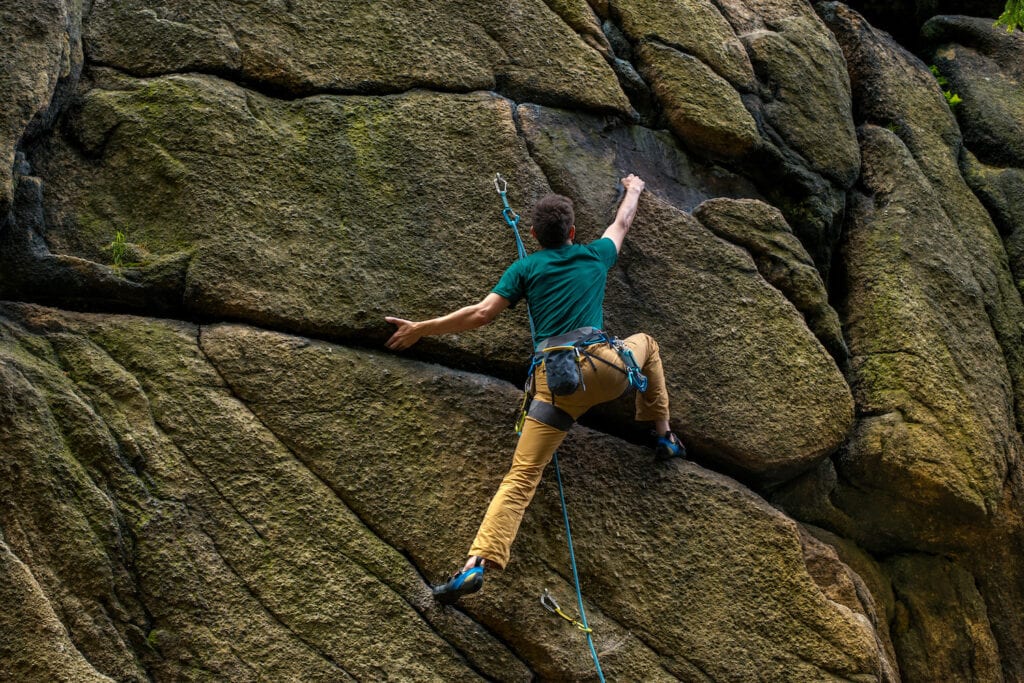
Bouldering is simply one form of rock climbing, so why categorize and discuss their differences?
All rock climbing forms arose from the age-old desire of humans to reach the highest point in their surrounding environment. To see what’s in the next valley or over the horizon. Eventually, that instinct turned into more sporting endeavors like mountaineering and peak bagging.
As more humans took up the idea and pursuit of climbing, they naturally began seeking to increase the difficulty level of their summits and rock faces. Once we reached most of the highest points around the world, we invented new challenges. These were shorter but more physically demanding, like single-pitch trad climbing and sport climbing.
Rather than tackling mountain peaks, most of today’s rock climbers aim for less than 100 feet (30 m) tall routes. This allows rock climbers who are rope climbing to ascend and descend multiple routes in a single day. It’s especially relevant in areas with pre-installed bolted anchors at the top of every route.
Common Types of Roped Climbing
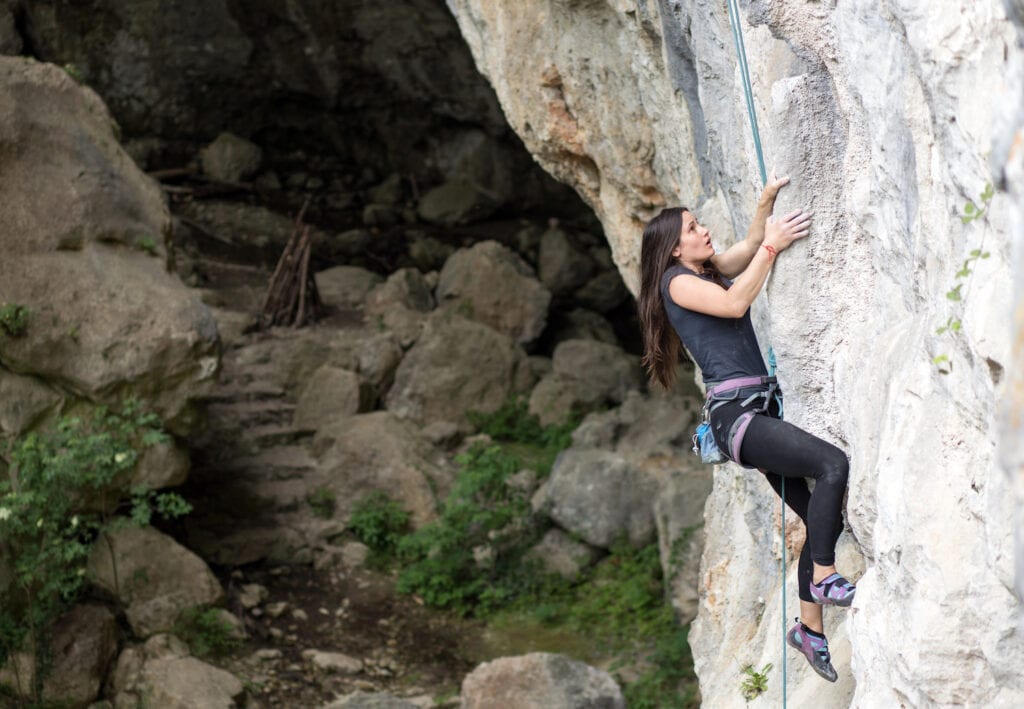
As we just mentioned, many climbing areas have designated routes with fixed gear already in place. You can find these climbing areas by searching online at MountainProject.com, TheCrag.com, etc. These sites also have phone apps to download route info for offline use.
You can also purchase the traditional printed guidebooks for many well-known climbing areas. Indeed, it can be helpful to have photos and route descriptions. This way, you can view it at a glance without relying on battery power or your chalky hands’ ability to navigate a touchscreen.
Sport Climbing

Some routes have bolts pre-placed in the rock every 7 – 12 feet (2 – 3.5 m) or so, all the way to the top, where there are bolted anchors. To climb this type of route, a climber ties in to a rope at the bottom and then clips the rope into each bolt as they pass by. If they fall, their belayer stops the rope. This way, the leader only falls to the last bolt that they clipped.
Sport climbing is the most popular form of lead climbing with ropes, in climbing gyms and outside. A wide range of difficulty ratings is available so that even beginner climbers can succeed quickly. And modern equipment and techniques have made sport falls relatively commonplace and safe.
While sport climbing is the most popular form of roped technical climbing, it’s only a few decades old. Before climbers started drilling holes into crags and installing permanent bolts, they used other means to protect themselves from falls and injury.
Trad Climbing
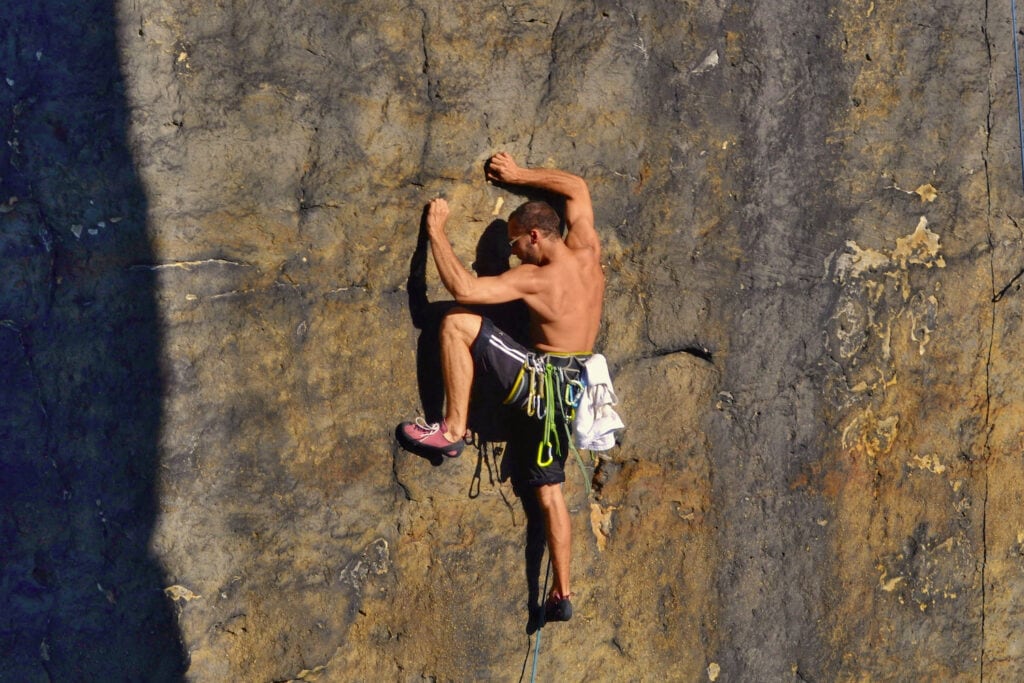
Trad climbing, short for “traditional” climbing, is a style that evolved from the gear and techniques first developed for summiting technical routes on high mountains.
Rather than clipping into previously installed gear, a trad leader uses natural features and protective gear they carry on their harness to affix the rope to the climbing wall. This gear might consist of a sling hitched around a rock horn, a nut wedged into a finger-width crevice, or a spring-loaded camming device placed into a wide crack.
Knowing the best piece of gear for any given scenario, and placing it correctly and safely, are skills that demand a great deal of experience. Before the advent of sport climbing, the difficulty and commitment required to start trad climbing made it harder for newcomers to get into rock climbing.
Aid Climbing
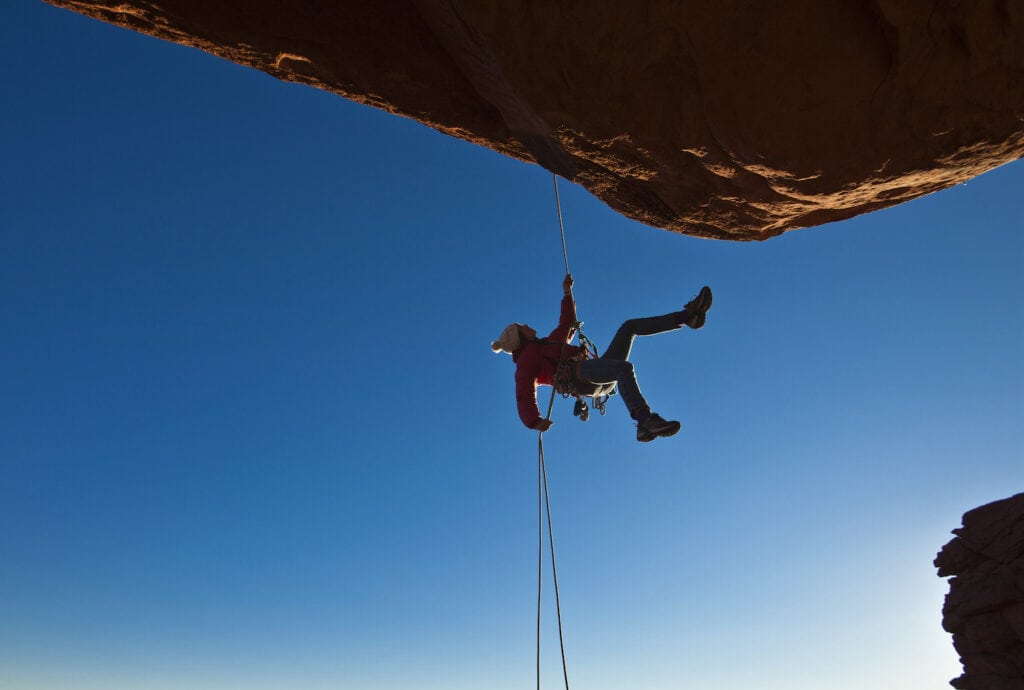
We should also briefly mention aid climbing since it’s essential to the evolution and development of traditional and sport climbing gear and techniques.
Aid is somewhat similar to trad, but a lead aid climber is allowed to ascend the route by any means necessary, including pulling on gear placements and installing an occasional bolt to move past featureless sections of the rock.
Aid rock climbing has its unique system of gear and techniques. A typical equipment list for aid climbers includes exotic items like bird beaks, RURPs, skyhooks, pulleys, jumars, knife blades, and etriers.
Many of the world’s tallest big wall climbs have only been successfully climbed with aid. A lengthy multi-pitch climb often entails a mix of free and aid climbing. While not for everyone, big wall climbing presents the ultimate test of a rock climber’s skills, knowledge, and route-finding ability. It also requires a great deal of perseverance under stress.
Top Rope Climbing
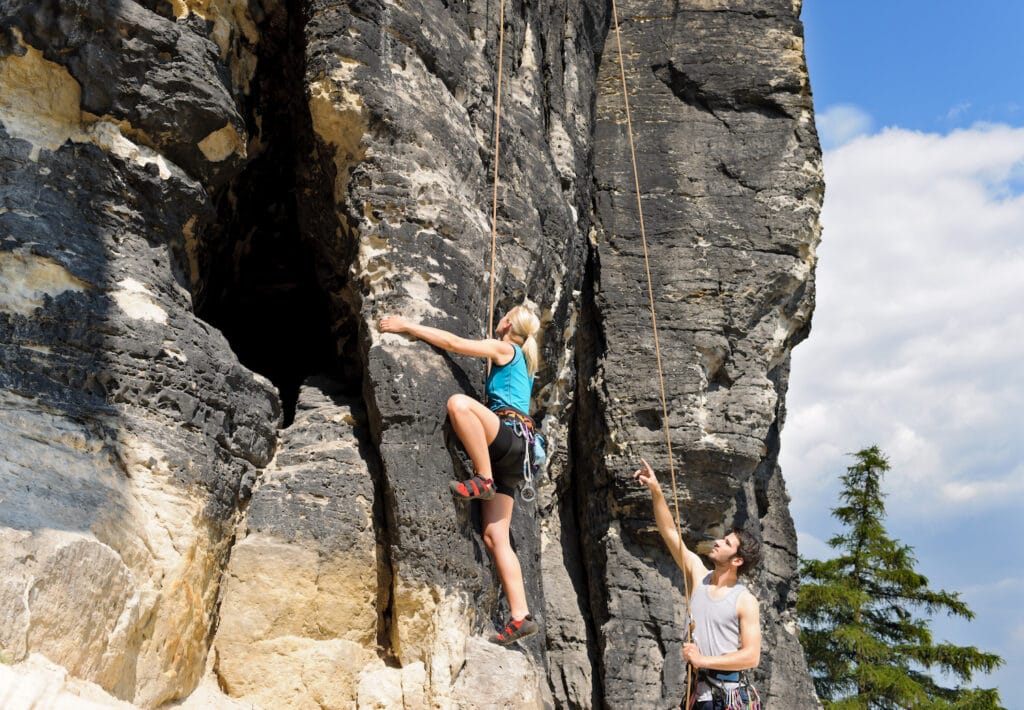
When you climb on a top rope, the rope is attached to a fixed anchor at the top of the route. Top roping is the opposite of lead climbing, where the climber is taking the rope up and affixing it as they go.
Most modern rock climbing gyms have a significant portion of wall space dedicated to routes with top rope and lead climbing routes. Learning how to belay and climb on top rope is the initial training step for most first-time climbers, indoors or outside.
Bouldering, the Purest Form of Climbing
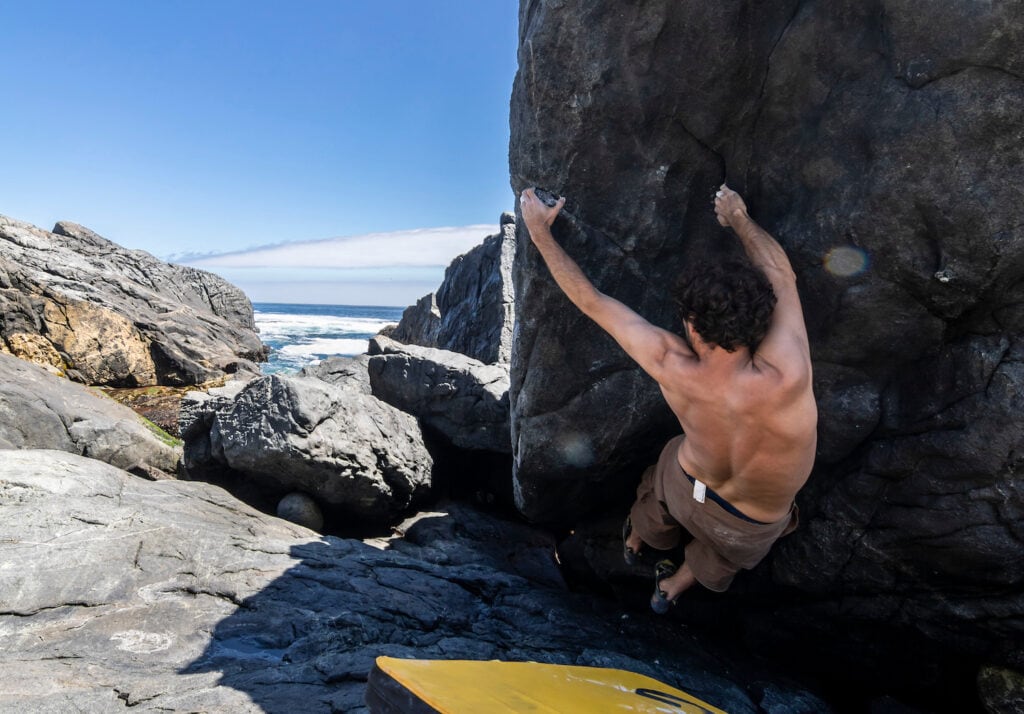
Bouldering takes the focus on short, challenging climbs to the ultimate end. Summiting a typical boulder requires only a handful of moves. As a result, there’s even more emphasis on each individual movement’s aesthetics and consistent quality, from one hold to the next.
A rock climber facing a boulder problem doesn’t need a harness, any dangling array of metal paraphernalia, or a rope dragging behind. This simplicity enables one to express their climbing abilities fully, without distraction. This allows them to achieve the greatest alignment between mind, body, and movement.
To the extent possible, an ideal bouldering problem maintains its difficulty rating on every move from top to bottom. If outdoors, the rock quality should be impeccable so that climbers can pull hard with confidence. Nothing destroys the mental game of climbing tall rocks without a rope-like the fear of a hold breaking at height.
Aside from not using a rope, what else should you know about the differences between bouldering vs. rock climbing?
Climbing Style Differences

Whether pulling yourself up using natural stone hand and footholds or on plastic resin holds while indoor climbing, rock climbing, and bouldering both use the same muscles and types of holds. So any fundamental skills will transfer from one discipline to the other to a certain extent.
However, there are subtle but crucial differences in the technical and physical challenges inherent in roped climbing vs. bouldering. Part of this is due to the nature of the average boulder problem: short and steep.
Overhanging moves generally require more upper body strength and a stronger core. Using your feet to help upward progress when they aren’t directly beneath you is more difficult. And you need your core to maintain the body tension that keeps as much weight as possible off your fingers.
Positioning one’s body in the most efficient way possible is an art on a horizontal roof as it is on a balance-y slab testpiece.
Dynamic Movement
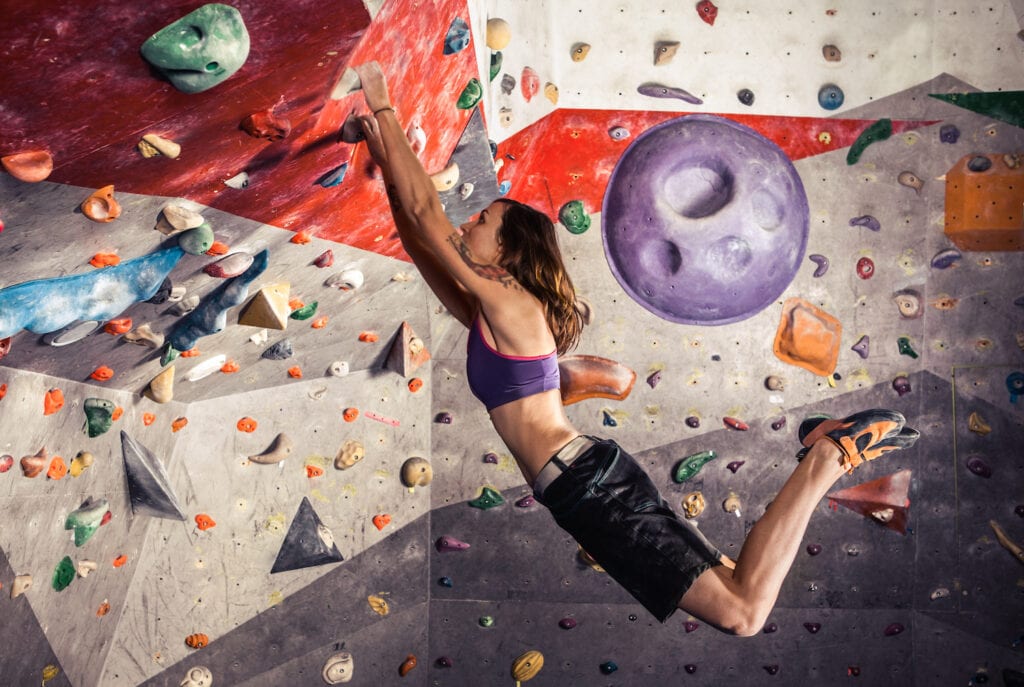
One other defining characteristic of bouldering vs. rock climbing involves acrobatic and explosive moves. For example, leaping from one set of holds to another and completely losing contact with the rock.
Dynamic movement like this was generally discouraged by mountaineers and climbers of the past. Lower quality equipment didn’t lend itself to taking risks. Therefore, the wisdom of the time was to avoid falling at all costs.
Nowadays, “dynos”—slang term for dynamic, leaping moves—are regular features on boulder problems, especially in a competitive climbing environment.
Bouldering vs. Rock Climbing Grades and Ratings
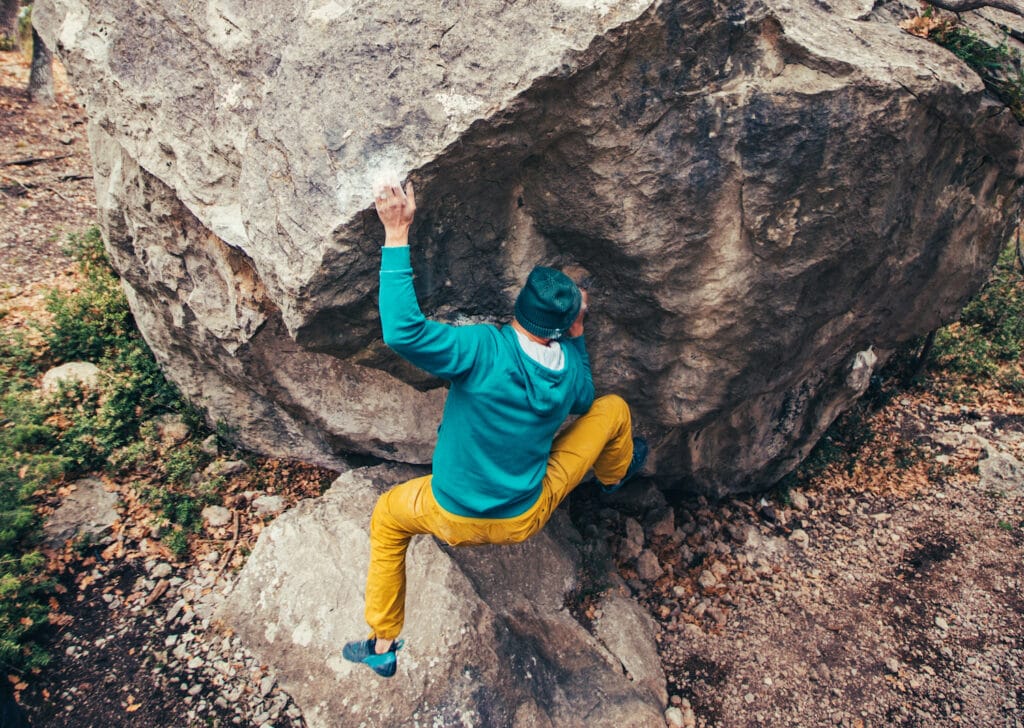
After rock climbing began to separate itself from mountain climbing as an athletic and recreational pursuit, different rating systems emerged globally. These grading systems are useful to define the relative difficulty of new climbs.
Traditional/Sport Climbing Grades
The most commonly used systems for rock climbing grades worldwide originated in the United States and France. They are the Yosemite Decimal System (YDS) and the “French scale.”
The British trad and sport rating system is well-known but mainly only used in the United Kingdom. There are many other unique difficulty rating systems for ice climbing, alpine climbing, etc.
The YDS, the French systems, and the boulder grade systems discussed below are all open-ended systems. So there’s no defined upper limit. The scales can continue to expand as climbers in the future get stronger and smarter.

Currently, the most difficult route in the world is rated at 5.15d YDS, 9c French scale.
As you can see in the chart below, the YDS system starts at 5.0, the threshold of 5th Class climbing. There are very few established routes below the 5.4 to 5.5 range in areas developed for technical rock climbing.
French Scale vs. YDS
Below is a chart showing the approximate equivalent ratings for the Yosemite Decimal System and the French scale for sport and trad route grades. Sometimes it’s useful to know how different ratings compare to one another. For example, it will help you if you plan a climbing trip to a destination that uses a different system.

Bouldering Grades
Because bouldering routes are so much shorter and generally more intense than taller rock climbing walls, the existing rating systems like the French and YDS weren’t considered appropriate or accurate for grading boulders. Therefore, the unique characteristics of this discipline prompted climbers to create new systems to rank and compare boulder problems.
Coincidentally or not, the two most popular bouldering rating systems emerged from the U.S. and France. There’s the V-scale and the Font system.
Font is short for Fontainebleau, a forested region near Paris that provided a training ground for French Alps climbers in the 1800s. It’s considered the oldest and largest developed bouldering area in the world.
Most of Europe uses the Font scale, while the Americas and many other countries without their own systems use the V-scale. Japan, Australia, South Africa, and other locales have their own rating systems, but they are not widely popular beyond their particular countries.
As noted, the Font and V-scales are open-ended. The most difficult boulder problems in the world at the moment are rated V16. There are several proposed V17s that have not been repeated, so those grades still require confirmation.
Comparing V-Scale and Font Grading Systems
Here’s a chart that illustrates equivalent grades between the V-scale and Font scale:
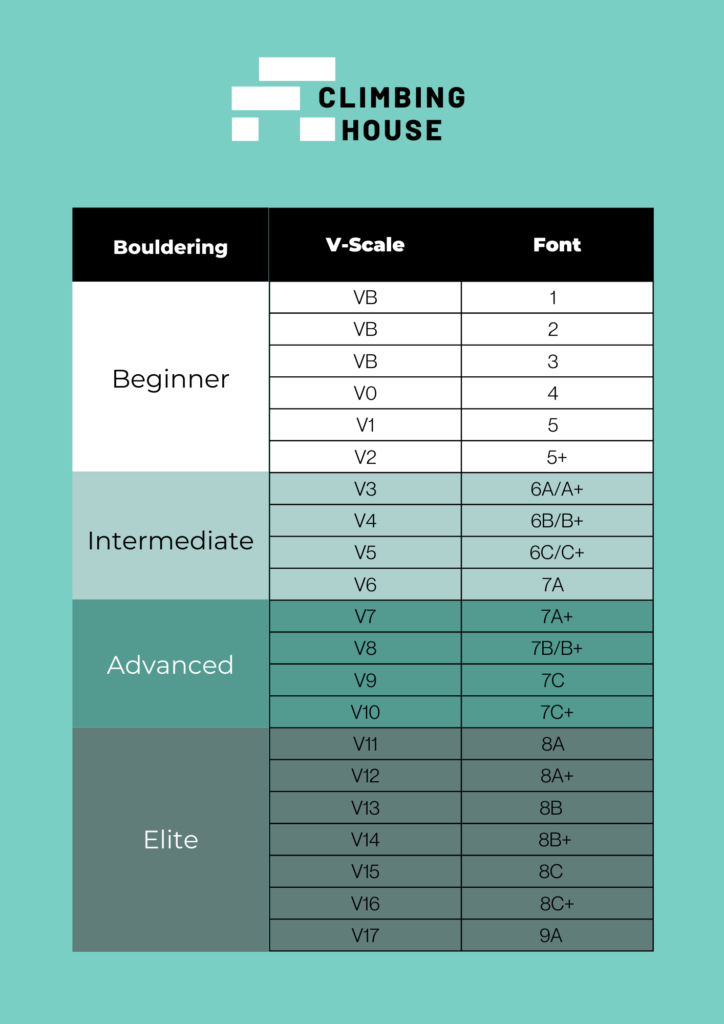
Different Training Routines
There’s a common stereotype that t’s better to have a bulkier and more powerful physique for bouldering. That’s because bouldering at a high level is more dependent on shorter sequences of burly, often radically overhung moves.
Don’t worry if you don’t look like a bodybuilder, though. Some of the best boulderers in the world have more slender frames. However, their iron-like grip, elite core strength, and masterful technique allow them to dominate. For examples, see Dave Graham and Adam Ondra.
Nonetheless, sport climbing and other forms of roped climbing lean more toward endurance on the power-endurance spectrum.

While all climbers should include finger strength training in their workouts away from the wall, you can tailor other parts of your routine based on your specific climbing goals and interests.
Suppose your latest project is an eight-move overhang on crimps to a slopey dyno finish and top out. In that case, the physical demands are incredibly different from an 80-foot, vertical face route on limestone edges and pockets.
As a basic rule, training for power tends toward shorter periods of more intense exercises, where you’re operating closer to peak power output. Training for endurance rock climbing is best served by doing lower intensity exercises for longer periods. For example, you can run top rope laps on a route well below your limit.
Risks and Injury Potential
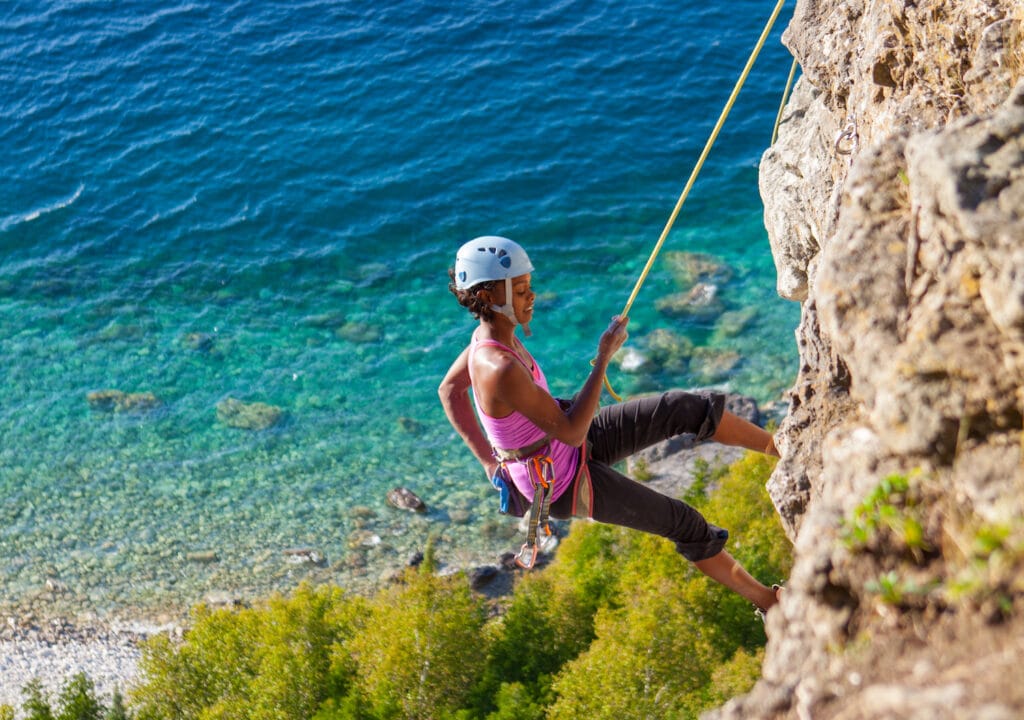
We have previously discussed the risks of falling and injury in bouldering vs. rock climbing. While we feel pretty confident saying that the likelihood of death is lower in bouldering than in other types of climbing, subjective opinions of the relative dangers of bouldering and rock climbing vary widely.
We can also say that outdoor boulders pose more risk than indoor bouldering gyms. Pulling on holds that never break and landing on a consistently flat cushioned floor significantly reduce risk factors and the incidence of injuries.
Non-climbers commonly perceive all forms of climbing as dangerous and life-threatening. As climbers, we all know that there are ways to control and mitigate risks to make climbing just as safe as many other sports.
Top roping in a climbing gym is probably safer than driving on an interstate highway in the U.S. Free rock climbing a big wall route on El Capitan is undoubtedly less so. Every climber must assess the risks in their particular situation and react accordingly.
If you study reported accidents related to technical rock climbing in North America, you will discover that most serious climbing incidents involve user error. One or more critical mistakes occurred in the climber’s decision-making process. Accidents caused by equipment failure or environmental conditions are much rarer than those caused by human error.
Equipment and Ease of Entry

Bouldering Has Minimal Gear Requirements
Nobody used a crash pad in the early days of bouldering when most practitioners were trad and sport climbing hard men and women. Those pioneers mastered the arts of jumping, falling, and downclimbing instead.
That perspective has mostly fallen by the wayside now. Serious boulderers usually agree that the more pads, the merrier, with spotters mandatory depending on height and the landing area.
So, if you’re already a rock climber, you may only need to acquire a crash pad, or bouldering mat, to get started in this new discipline.
If you’re a complete newbie, you’ll want purpose-built rock climbing shoes, chalk, and a chalk bag to keep it in. You don’t have to boulder in climbing shoes or coat your hands in gymnastic chalk to absorb sweat. However, these things increase safety immensely by reducing your likelihood of falling.
Using proper shoes will help you improve your technique quickly and advance into more complex problems.
Fundamentally, this describes all the stuff you need for outdoor bouldering safely. Other optional items might be appropriate depending on your needs. For example, you can also use a brush to clean holds or a chalk bucket if you favor indoor bouldering.
Equipment Required for Roped Climbing
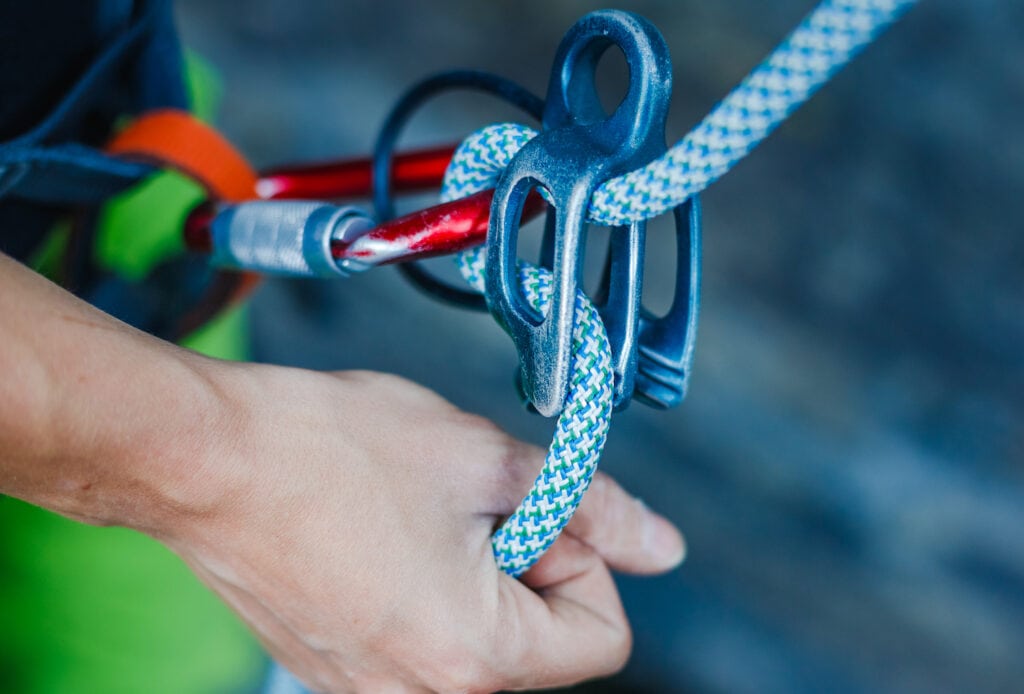
Technical rock climbing has a well-earned reputation as a hobby that requires an enormous amount of expensive gear and equipment. On the other hand, the gear often lasts several seasons, so the relative costs are reasonable compared to other sports.
Sport Climbing
Sport climbing requires the smallest amount of gear compared to trad and aid.
In addition to shoes and a chalk bag, a sport climber can get by with a few additional items: harness, belay device, dynamic rope, quickdraws, a personal anchor system, and a few extra slings and carabiners to build top-rope anchors.
This setup is the minimum necessary to lead a sport climbing route, belay your climbing partner, and lower or rappel from the top of a pitch.

If you want to start sport climbing with the least expense, a harness and belay device will allow you to begin top-rope climbing at an indoor wall. You can even rent the equipment first if you’re still deciding whether to invest.
Trad Climbing Gear
When it comes to traditional gear and practicing using it, you’ll have to venture outside to real stone. That’s the only place you’ll find the rock features like cracks, pockets, horns, chickenheads, and chockstones necessary to place protective pieces of gear when leading trad style.
Climbing rocks in the traditional style takes more gear than sport rock climbing and bouldering. You’ll need most of the equipment listed above to lead a sport climbing route, with a few additional items to complete your rack.
Instead of clipping his rope into quickdraws and bolts, a trad leader must place a cam, nut, or other pieces of gear so that it is securely wedged into a crack or crevice. Then he uses a quickdraw, or sling and carabiners, to attach his rope to this piece of gear.
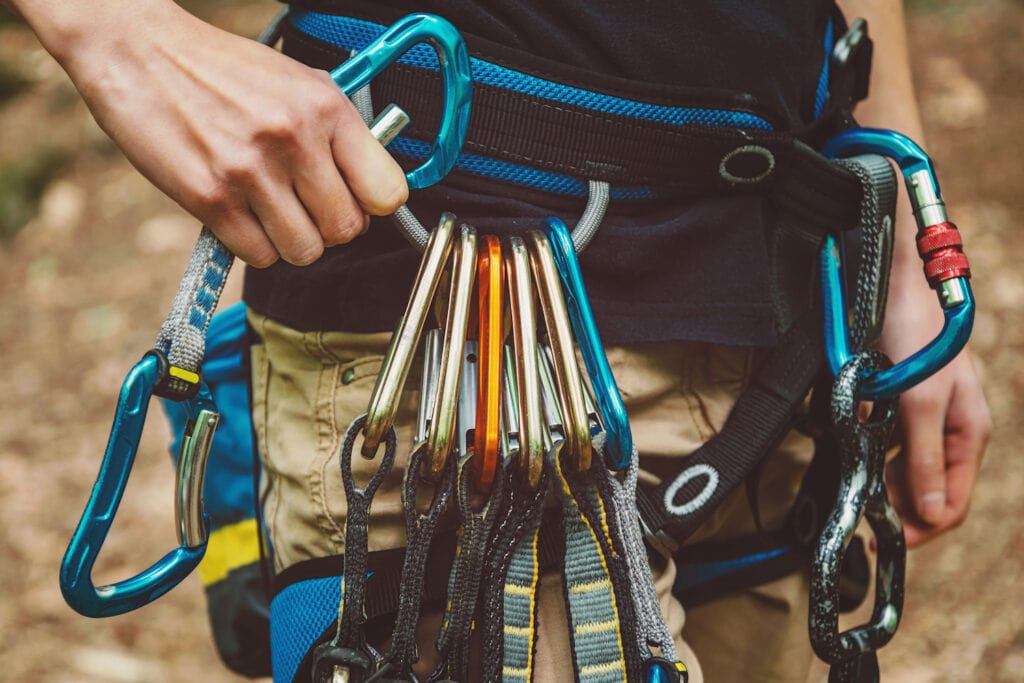
You may not know exactly what features you’ll find on a given trad route, so you need to be ready for many variables. How wide are the cracks on the route? If there are no cracks, what other features are there, and how can they be safely used for protection?
A standard rack for lead climbing an unknown route might consist of something like the following: a full set of cams from #0.5 to #3, a full set of nuts (standard sizes), a few hexes or Tricams, a dozen regular and four locking carabiners, standard and oversize runners.
Be aware that this is the bare minimum. If your trad objective contains unusually wide cracks or tiny seams, you may need additional specialized pieces for those environments, like Big Bros, oversize cams, micro cams, and micro-nuts. If you’re leading a pitch with one continuous crack with a reasonably consistent width, you’ll need multiple pieces of the same size to protect the route.
Aid Climbing
We briefly touched on the array of special equipment that aid climbers use to practice their craft. Aid and big wall climbing are the most gear-intensive disciplines, and this type of multi-pitch rock climbing requires the most advanced and diverse climbing skills.
In addition to all of the gear one might assemble for a full traditional climbing rack, you should count on buying at least the following:
- One more climbing rope
- A selection of pitons and hooks, wires, pulleys, ascenders, aiders, daisy chains
- A fifi hook
- More carabiners
- More slings.
- A haul bag to carry all your extra food, clothing, and personal gear
- Plus a portaledge if you plan to sleep overnight on the wall.
In short, this style of climbing is not a casual endeavor. If this is your objective, be sure and seek out expert training from an experienced climbing partner, a certified guide, or a climbing school.
Rock Climbing vs. Bouldering FAQs
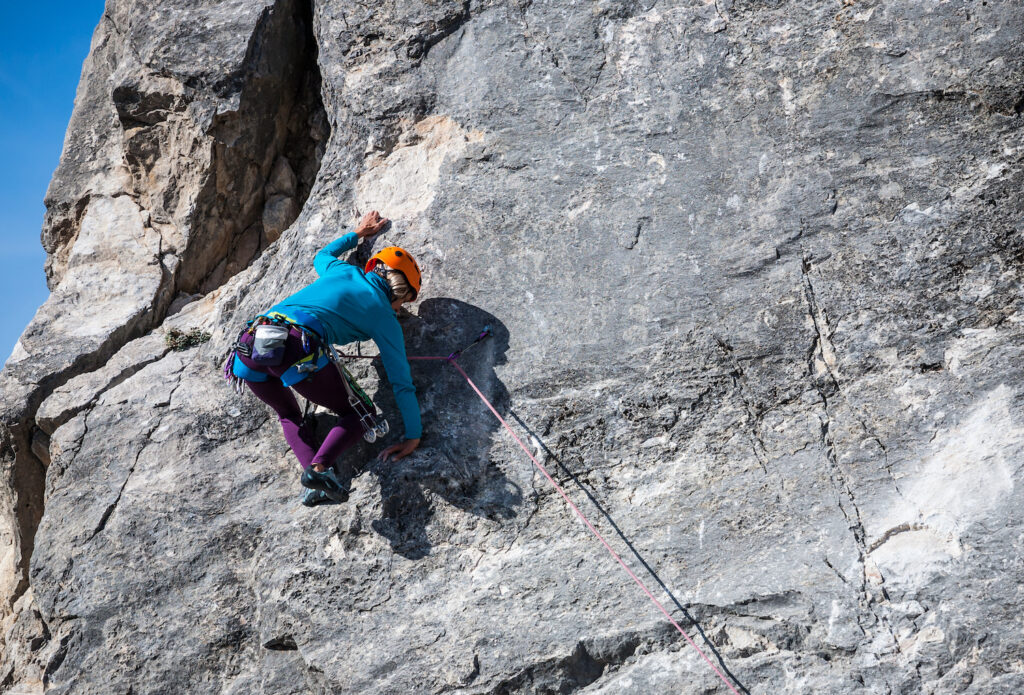
This depends on your climbing goals and mindset. One advantage to bouldering is that you can practice it anywhere, and you aren’t dependent on following routes from a guidebook or other external source. Indeed, boulder problems at the lower end of the bouldering rating scale are still highly challenging for newcomers to the sport. Still, you can choose to enjoy climbing boulders that are easier than V0 until you’re ready for the next level of difficulty. You are only competing against yourself and the rock. For beginners, it’s best to forget about ratings and focus on fun and safety.
Any dedicated sport climber or boulderer will tell you the definitive answer to this! Both climbing disciplines do focus on slightly different skills and abilities. Still, there are more similarities than not, so most climbers practice more than one style, depending on circumstances. At the same time, people also gravitate toward one or the other style based on their climbing goals, proximity to indoor and outdoor climbing locales, availability of partners, and other factors.
Most people consider bouldering a form of technical rock climbing due to the high levels of strength, flexibility, and climbing technique required to succeed.
